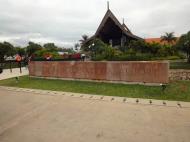Siem Reap-Angkor International Airport
(IATA: REP, ICAO: VDSR)Airport type: Public
Serves: Siem Reap
Elevation AMSL: 60 ft / 18 m
Coordinates: 13°24'38.40?N 103°48'46.22?ESiem Reap-Angkor International Airport (IATA: REP, ICAO: VDSR) (French: Aéroport International De Siem Reap) is the airport in Cambodia handling the greatest number of passengers. It is located in Siem Reap, home of Angkor Wat. The full architecture design of the airport was developed by Archetype Group. Official inauguration of Siem Reap-Angkor International Airport's new terminal was in August 28, 2006.
As of 2008, extensions to the airport's apron and parking areas are taking place. Air Traffic Control is provided by CATS (Cambodia Air Traffic Services), with full approach and aerodrome VHF facilities being housed in the control tower, between the fire station and the domestic terminal. Area control is still provided from CATS Centre in Phnom Penh (Pochentong).
VHF frequencies used at Siem Reap are: Tower: 118.000 MHz (AM) Approach: 124.300 MHz (AM) ACC (FIR): 127.500 MHz (AM) Ground (apron): 121.750 MHz (AM) ATIS (WX): 129.950 MHz (AM) Tower – fire 3A: 143.750 MHz (FM) CATS are also responsible for clearing takeoffs and landings of tourist helicopters from the "Big Balloon" site, 3km away, near Angkor Wat. Both Helicopters Cambodia and Sokha Helicopters operate from the airport, with Sokha mainly operating from the Big Yellow Balloon site. The airport itself is located some 6km outside Siem Reap, just off National Route 6 north. Runway alignments are 23 & 05, with only 23 being used for takeoff, due to flight restrictions over Angkor temple.
Airlines and destinations
Airlines: Destinations
AirAsia: Kuala Lumpur
Asiana Airlines: Seoul-Incheon
Bangkok Airways: Bangkok-Suvarnabhumi
Cambodia Angkor Air: Ho Chi Minh City, Phnom Penh, Sihanoukville
China Eastern Airlines: Kunming, Nanning
China Southern Airlines: Guangzhou
Jetstar Asia: Singapore
Korean Air: Busan, Seoul-Incheon
Lao Airlines: Luang Prabang
Malaysia Airlines: Kuala Lumpur SilkAir: Da Nang, Singapore
Vietnam Airlines: Hanoi, Ho Chi Minh City, Luang PrabangAirfield
Length: 2,550 m
Width: 45 m, with shoulders 2.5 m. wide each
Perpendicular taxiway: 1 (length: 240 meters, width: 20 meters and 10 meters of shoulders).
Under construction: 1 (length: 600 meters, width: 23 meters and 15 meters of shoulders)
Number of stands: 8
Navigation aids and visual aids: VOR/DME; NDB; PAPIStatistics
Year: Total Passengers: Total Aircraft Movements
2001: 449,690: 12,407
2002: 572,664: 13,605
2003: 551,344: 11,965
2004: 799,743: 15,476
2005: 1,038,118: 16,923
2006: 1,360,390: 18,857
2007: 1,732,428: 22,014Web Reference:
http://en.wikipedia.org/wiki/Angkor_International_Airport
Siem Reap
Siem Reap, is a province located in northwestern Cambodia, on the shores of the Tonle Sap lake. The province came under the control of the Thai kingdom of Ayutthaya and was later returned to Cambodia in 1907 after French gunboat diplomacy pressured Thai concession of the area.
The area became part of a disputed territory between France and Siam (now Thailand) which led to the Franco-Thai War in 1941, resulting in victory for Thailand and a return back to Thai control. The province again reverted to Cambodia in 1946, after the end of WW2 and French diplomatic pressure. Today it is best known for the ruined temples of Angkor.
Located in northwest Cambodia, Siem Reap is a major tourist hub in Cambodia. The most recognizable of the temples, Angkor Wat, literally Capital Temple, was built by King Suryavarman II during the early 12th century. Other sites of interest near Siem Reap include Angkor Thom built by Jayavarman VII, Banteay Srei, Ta Prohm, as well as hundreds of other temple ruins. Angkor, and the surrounding area that would later become known as Siem Reap, faced repeated invasions from the Thais, and ceased to be the capital after a seven-month siege in 1431. The capital was moved to Phnom Penh in 1432, and then to Lovek and Oudong, before moving back to Phnom Penh in 1866. The temple ruins were visited by Western explorers and missionaries before the 19th century, but Henri Mouhot is generally seen as having 'discovered or really re-discovered' Angkor Wat in 1860.
Subdivisions
The province is subdivided into 12 districts, 100 communes and 907 villages.
1701 Angkor Chum
1702 Angkor Thom
1703 Banteay Srei
1704 Chi Kraeng
1706 Kralanh
1707 Puok
1709 Prasat Bakong
1710 Siem Reap
1711 Sout Nikom
1712 Srei Snam
1713 Svay Leu
1714 Variin
Siem Reap International Airport, Siem Reap, Cambodia Map
 Editor for Asisbiz: Matthew Laird Acred
Editor for Asisbiz: Matthew Laird Acred
If you love our website please add a like on facebook
Please donate so we can make this site even better !!










